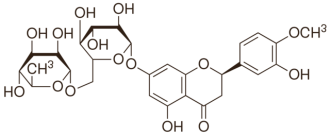|
Definition: "An ergogenic aid is any substance or phenomenon that enhances performance "
|
|
||||||||
15.10.2012 |
|
|
Hesperidin stimulates formation of new muscle tissue
A flavonoid that is found in lemons, limes and grapefruit stimulates the development and recovery of muscle tissue. Pharmacologists at Ewha Womans University in South Korea discovered that hesperidin has an anabolic effect on young muscle cells, forces stem cells to develop into muscle cells and speeds up the recovery of damaged muscle tissue.
Hesperidin is a sugared flavonoid found in citrus fruits; old studies refer to it as 'vitamin P' [its chemical structure is shown below]. After ingestion, micro-organisms in the intestines separate the sugar group from the molecule and hesperidin is released. Animal studies have shown that this substance lowers blood pressure, improves cholesterol levels and inhibits osteoporosis. According to one animal study published by Inra in France in 2010, hesperidin boosts anabolic mechanisms in bone cells. [J Nutr Biochem. 2010 May;21(5):424-31.]
The researchers discovered that hesperidin's activity in the muscle cells runs via another anabolic signal molecule, MyoD. Muscle cells develop and grow stronger if MyoD attaches itself to the DNA. Hesperidin facilitates the process of attachment; it doesn't boost the production of MyoD, but does help the cell to respond better to MyoD.
The researchers discovered that hesperidin also activates MyoD in stem cells. This means that hesperidin forces stem cells to develop into muscle cells and not into fat cells.
Based on the data they collected the Koreans assume that hesperidin can help damaged muscle tissue recover. They tested their theory in an experiment with mice, in which muscle tissue had been frozen and thus damaged. When the Koreans gave the mice an intraperitoneal injection of hesperidin for seven days in a row, their recovery was faster.
Converting the doses to human levels, you would need 0.8 – 4.1 mg hesperidin per kg bodyweight per day. So if you weigh 90 kg that would amount to 72 – 360 mg per day. Quantities like this are not available through food. According to a review study done at Tufts University 100 g grapefruit flesh contains about 2-4 mg hesperidin. [Journal of Food Composition and Analysis 19 (2006) S74–S80.] Lemons and limes are a better source, but they still only contain about 16 mg hesperidin per 100g. Supplements developers: grab your chance.
"The ability of the dietary flavonoid, hesperedin, to activate MyoD and subsequent myogenin expression and to promote muscle differentiation and regeneration may indicate beneficial therapeutic potential for recovery from athletic injury and treating muscle diseases", the researchers conclude.
Source:
|
|



